Rich rarely passes up an opportunity to mention his gherkins. “Look at how magnificent they have grown” he squeaks all summer long. “Behold my giant jar of crisp, pickled gherkins” he boasts whenever I pop round his house for another tedious team meeting.
While it’s true that his gherkins are firm, knobbly and sour enough to make a chef blush, I much prefer to grow and pickle onions, believing that no vegetable tastes as good after a prolonged bath in vinegar than the princely edible allium.
Cracking open a jar of my pickled onions has become a Christmas day tradition, as ritualistic as the pulling of crackers, the flambéing of Christmas pudding and the opening of a bottle of strong, dark beer as soon as breakfast has settled.
So now, with another November pickling safely negotiated, I feel the time is right to share my methods, giving you all the chance of getting one up on Rich and his jar of knobbly gherkins.
A step-by-step guide to pickling onions
1 First, choose your onions
You can use any type of onion (slice them if they’re big) but shallots are the best. Aside from being the ideal size, their gentle sweet flavour works wonderfully when pickling. There are even some varieties that have been specially marked out for their pickling excellence which are available to sow or buy if you look hard enough – take a look at this guide on how to plant onions if you do decide to sow your own. The key attribute for prime onion pickleability is a bullet-like firmness, again something you get from a fresh shallot.
2 Next, peel your onions
You could reach straight for the knife to whip off the brown skins but, for a more precise and easy peel, first soak them for five minutes in a bowl of boiling water and rinse until cool enough to handle. Trim the bare minimum from the tops and bottoms (excess trimming could cause more layers to slip off) and the skins should peel away with ease.
3 Salt your onions
Now roll your bald onions in salt and leave in a bowl overnight, rinsing the salt away in the morning before patting dry. Although this stage is optional, the salt-and-rinse method will extract moisture from within the onion and you will be rewarded with a crisper, crunchier, firmer pickle in the long run. Worth the extra effort.
4 Prepare your pickling vinegar
You could use cider vinegar.
You could use wine vinegar.
You could use clear distilled vinegar for clarity of onion.
Or you could use a combination of all three.
But for the best results use good ol’ dirty brown malt vinegar. You’ll need roughly an equal volume of water to weight of onions – ie 100ml vinegar for every 100g of onions. And you also need 40g white sugar per 100g onions.
Pour the vinegar into a pan and add your sugar and the allaimportant pickling spices. I go for the following:
1 teaspoon mustard seed
1 teaspoon of black pepper
1 bay leaf.
I also produce an extra jar with a teaspoon of dried chilli added, should anyone dare complain that my standard pickle isn’t spicy enough.
Gently heat the vinegar and spices for five to ten minutes (don’t let it boil), stirring to dissolve the sugar, then set aside to cool.
5 Pack your pickles
Now is the time to pack your onions into jars. You’ve sterilised your jars first, yes? If not, wash in hot water and dry in an oven on a low heat. Or chuck them in the dishwasher. Make sure you allow them to cool before the cooled vinegar goes anywhere near the glass.
Place the onions into the jar leaving as little space between them as possible (think like a dry-stone-waller and build layers of onions according to size and shape). Fill with the pickling vinegar, including the spices (although I always remove the bay leaf), until the onions are covered. Seal the jar and store somewhere cool and dark, six weeks being an optimum minimum length of time (but don’t worry if you need to eat them sooner).
Pickle perfection is as easy as that. Enjoy.
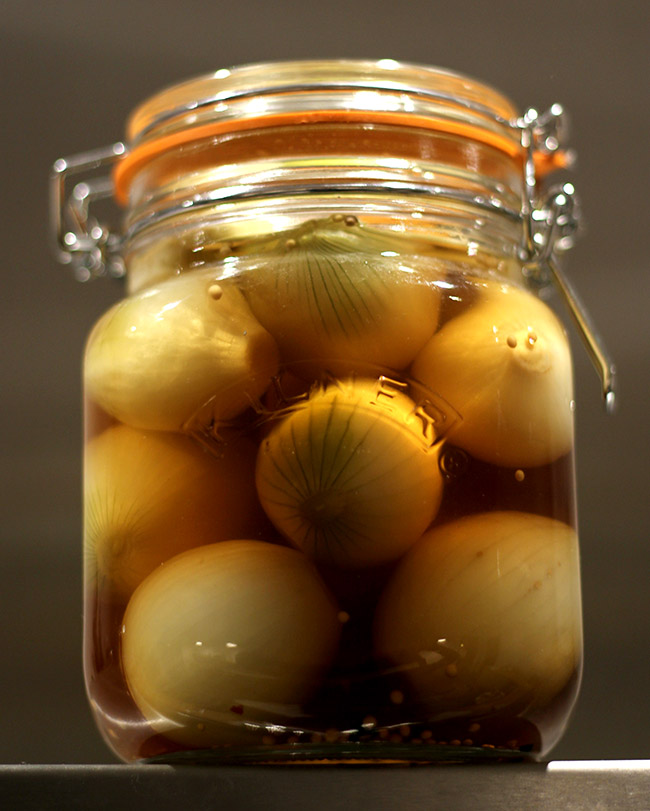
To take a gander at Rich’s gherkins and learn how he pickles them, head on over to this page
This is a sponsored post


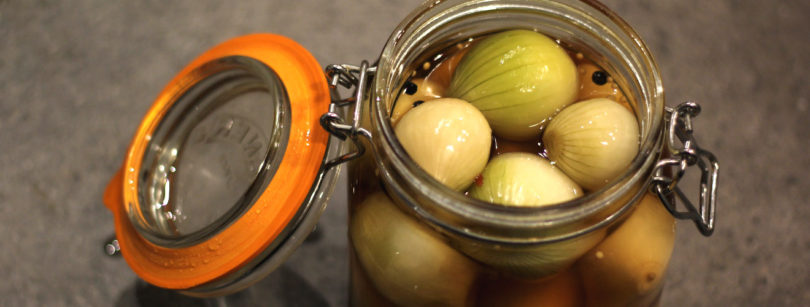
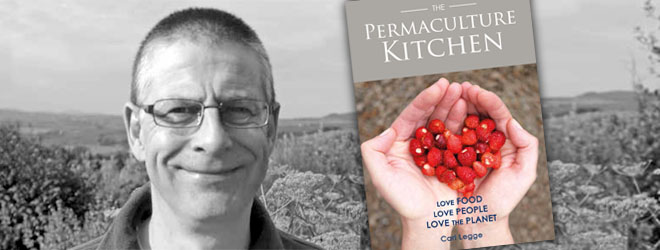
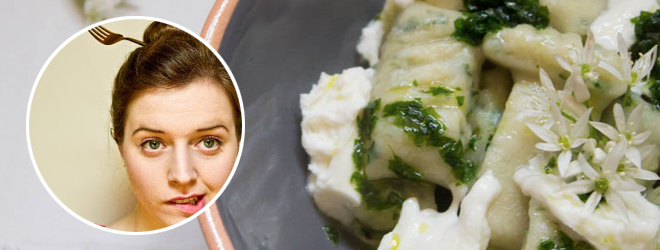


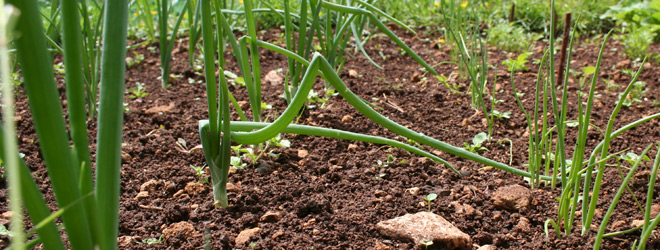
How many tsp of spices per 500ml of vinegar should you use?
The recipe is for 100g onions + 100ml vinegar so for 500ml vinegar use five times the quantities.
However, spices aren’t going to ruin your onions so you can add as much or as little as you wish.
Maybe err on the side of caution for your first attempt and make a note of how much you used, adjusting for future pickling endeavours.
Hope that helps.
I do mine in batches of 1 kg as I have quite few customers for them. I don’t use as much sugar as your recipe as most of my customers seem to prefer them without although I might try a few jars of sweet pickle. I use a mix of spices and although I always put some in the jars there are usually quite a few left over. Can I use these again in my next batch of vinegar or should I discard them and use a fresh mix? Thanks for some of the tips you give, I have always wondered how long to leave them in the pickle before
they are ready to eat, I give mine a minimum of one week with a recommendation that they should be kept a bit longer before eating them But I don’t have the space to keep them for 6 weeks!!
Hi Adrienne
Yes, this recipe is for pickles that are on the sweet side of things. I think we must be developing a sweeter tooth as we get older, but we do find they go extremely well with good quality cheese like this.
I have often wondered about reusing the vinegar and spices but have never tried it. I can’t see why it wouldn’t work, perhaps topped up with a few more ingredients, but perhaps someone else can tell us if it’s worth doing or not?
I can’t test it out myself as I can’t take onions or vinegar although of course I do make and sell chutneys that are sweet so I might try some sweet pickled onions just to see. It does seem to have to discard the spices that have only been used once, especially as they can be expensive. I usually buy them in bulk as supermarket supplies would put the costs far too high. I think as we get older we probably need more sugar for the extra energy we are expending. That’s my excuse anyway. Happy pickling.
Use the vinegar on chips. Pickled onion vinegar on chips is amazing.
For what it’s worth, here are my observations! Early season onions are best – October time – they are the firmest & smaller than those sown & harvested later. They used to say peel the onions until all green layers have gone, but I don’t buy that! I soak my peeled onions overnight in a brine solution, dry them off & fill a jar with them. Add standard pickling spice from Schwartz or similar, no sugar. I grow my own Jalapeno chillies & I chop them up – red and green – and add to the onions. About 5-6 chillies to 5lb of onions. Adjust to taste of course & including the seeds will increase the strength of spiciness A decent quality malt vinegar to pickle them is best, I’ve found. Left for 4-6 weeks is best, a lovely crunchiness to them & the vinegar & chillies have blended nicely. Pretty simple really! Many find shallots more to their taste & that’s fine, but good quality pickling onions are my favorite & the Bedfordshire heritage onions are the best.
Wow, I reckon you really like a pickled onion! That’s really useful information so many thanks for taking the time to post your observations. Happy pickling!
[…] This peppery, bay-leafy version sounds like it’ll be perfect with your ploughman’s. Here’s a thoughtful post on the general principle of pickling your onions. As always, the Online Veg Box […]
[…] How to pickle onions – Two Thirsty Gardeners […]
I’ve only been growing my own since 2020 and am about to try pickling onions and shallots for the first time, hence my visit to this site. Thanks to all contributers for the great advice.
I have some multi-sown Bedfordshire Champion and Red Barron onions i.e. sow 5 – 7 seeds per module and plant out without thinning. You get smaller but more onions. Space the plants a little further apart than usual. I’ll use the larger ones in each group for the kitchen and use the smaller ones for pickling.
Happy growing and pickling.
Hi. As a Westerner in Asia we pickle and brine everything using both local and traditional ways. From sweet to sour. And salty. Re – re-using the liquor. From my experience, and also from simple chemistry, when pickling the aim is to replace the items water with vinegar or brining – reducing the acidity/ph being around 2/2.5, preserving and killing bacteria and stoping the natural fermentation from the lactobacilli’s present in the veg. The problem with re using the brine is likely to be the lack of ph (acidity) and salt from water released by pickling and also can induce fermentation in another batch. And the punch of the spices.
We tend to drink the strained vinegar. From onions, garlic, asparagus etc (diluting with water or juice), hard veg. Great for digestion, wellbeing. But NEVER re-use or drink the egg liquor from pickled eggs or soft veg like dill, cucumber etc. So generally there is no liquor left to re-use hahaha
That’s great information. Many thanks for sharing it.
concerns me that 40gms of white sugar per 100gms onions seems a lot ie per 500gms onions/200gms sugar. I like a crunchy strong flavoured pickled onion. what would be the result if I left the sugar out?
Yes, this recipe is somewhat on the sweet side. I’ve just had a look at a recipe on vinegar aces Sarson’s website and they use 100g per 500g onions. I guess it’s all down to personal preference. I think the sugar probably helps with the preserving side of things, so if you don’t include it then your onions might not keep as well. But I’m not entirely sure on that. Let me know how you get on.
Thank you
They turned out perfect.
Hurrah!